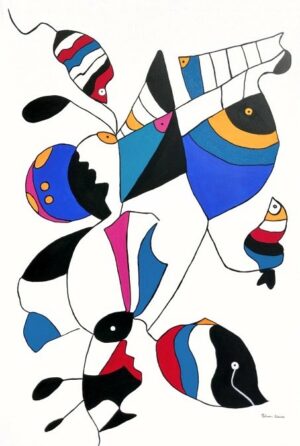Discover the Brazilian Baroque and 15 of its main artists
Learn how the Catholic Church influenced this artistic style

Contexto e definição do Barroco brasileiro
The Brazilian Baroque begins with the arrival of colonizers, mainly Portuguese, laymen and religious. Its full development takes place in the 18th century, 100 years after the emergence of the Baroque in Europe, extending until the first two decades of the 19th century.
As a style, it is a fusion of different Baroque trends, both Portuguese, French, Italian and Spanish. This mixture is accentuated in the secular workshops, multiplied throughout the century, in which Portuguese masters join the children of Europeans born in Brazil and their caboclo and mixed ethnicity descendants to create some of the most beautiful works of Brazilian Baroque.
It can be said that the amalgamation of popular and erudite elements produced in craft brotherhoods helps to rejuvenate different styles among us, resurrecting, for example, forms of late German Gothic in the work of Aleijadinho (1730-1814). The movement reached its artistic peak from 1760 onwards, mainly with the rococo variation of the Minas Gerais baroque.

During the 17th century the Church played an important role as a patron in colonial art. The various religious orders (Benedictine, Carmelites, Franciscans and Jesuits) that settled in Brazil since the mid-16th century developed a sober and often monumental religious architecture, with straight facades and plants of great ornamental simplicity, in keeping with the European Mannerist taste.
It is only when lay associations (confraternities, brotherhoods and third orders) take the lead in sponsoring artistic production in the 18th century, a moment when religious orders see their power weakened, that the Baroque becomes fruitful in regional schools, especially in the Northeast and Southeast of the country.
Obras em Destaque
However, the first manifestation of Baroque traits, although mixed with Gothic and Romanesque styles, can be found in the missionary art of the Sete Povos das Missões in the region of the La Plata Basin. There, for a century and a half, a process of artistic synthesis developed at the hands of the Guarani Indians based on European models taught by missionary priests.
The buildings of these peoples were almost completely destroyed. The most important ruins are those of the São Miguel mission, in the state of Rio Grande do Sul.
The first manifestations of the Baroque spirit in the rest of the country are present in facades and pediments, but mainly in the decoration of some churches, also in the mid-17th century. The gilded baroque carvings in gold, in the Portuguese style, are scattered throughout the Church and Monastery of São Bento do Rio de Janeiro, built between 1633 and 1691.

Credits: Leonardo Jorge / Source: Flickr
Access: https://viajeibonito.com.br/lugares-para-conhecer-no-rio-de-janeiro-de-graca/rio-de-janeiro-mosteiro-de-sao-bento/
The leaf motifs, the multitude of little angels and birds, the dynamic figure of the Virgin in the main altarpiece, project a baroque atmosphere within a classical architecture. Baroque vegetation is introduced in Bahia at the end of the 19th century. XVII in the decoration, for example, of the former Church of the Jesuits, current Church Cathedral Basilica, whose construction of the chancel, with its bunches of grapes, birds, tropical flowers and angel-boys, dates from 1665-1670. In Recife, the so-called Golden Chapel or Chapel of the Novices of the Third Order of São Francisco de Assis stands out, idealized in the economic heyday of Pernambuco, in 1696, and completed in 1724.
Between the 1700s and 1730s, carved stone vegetation tends to spread on the facades, as an imitation of the altarpieces, following the logic of Baroque ornamentation. In 1703, dynamism conquered the exterior for the first time in an ostensible way in the Plateresque-style facade of the Church of the Third Order of São Francisco da Penitência, in Salvador.
However, it is worth noting that such exuberance represents an exception in Brazilian Baroque, because even in its heyday, national Baroque churches, such as the Portuguese ones, are marked by a contrast between the relative simplicity of their exteriors and the rich interior decorations, symbolizing thus the virtue of recollection, a necessary requirement for the Christian soul. These first 30 years mark the spread of the “Portuguese national style” in Brazil, without major variations in the different regions.

Credits: Ricardo André Frantz
Change of Focus
It is noted that, in the mid-eighteenth century, the loss of economic and political strength began a period of certain stagnation in the Northeast, with the exception of Pernambuco, which knew the rococo style in the second half of the century.
The focus is on Rio de Janeiro, which became the capital of the colony in 1763, and the region of Minas Gerais, developed at the expense of the discovery of gold (1695) and diamond mines (ca.1730). It is not by chance that two of the greatest Brazilian
Baroque artists worked precisely in this period: Mestre Valentim (ca.1745-1813), in Rio de Janeiro, and Aleijadinho, in Ouro Preto and surrounding areas.
It is in the softness of the Minas Rococo style (from 1760 onwards) that the most original expression of Brazilian Baroque can be found. Extreme popular religiosity, under the exclusive sponsorship of lay associations, is expressed in a restrained and elegant spirit, generating harmonious and dynamic temples of architecture in circular planes, with graceful soapstone decoration.
The monumental buildings are definitively replaced by intimate temples of simple dimensions and exquisite decoration, more appropriate to the spirituality and material conditions of the people of the region. The illusionist painting on the nave ceiling (1802) is by one of the most talented Baroque painters, Manoel da Costa Ataíde (1762-1830).
Characteristics of Brazilian Baroque
- Dramatic language;
- Exaggeration and exaggeration;
- Use of figures of speech;
- Union of the religious and the profane;
- Dualistic art;
- Game of contrasts;
- Appreciation of details;
- Cultism (play on words);
- Conceptism (game of ideas).
In Baroque literature, texts reflect elaborate and extravagant elements, where details are valued in a game of contrasts or counterpoint.
The language of this movement united medieval values to those of Greek and Latin culture, evidenced with the Renaissance.
In general, the baroque in literature is marked by characteristics that show the play of words and ideas. In addition, the use of figures of speech such as metaphor, inversions, hyperbole, paradox and antithesis is remarkable.

Access: http://www.ipatrimonio.org/wp-content/uploads/2017/05/Santa-B%C3%A1rbara-Igreja-Matriz-de-Santo-Ant%C3%B4nio-Imagem-Patrim%C3%B4nio-Espiritual4.jpg
The main artists of the Brazilian Baroque
- Augustine of Jesus – Sculptor
- Aleijadinho (Antônio Francisco Lisboa) – Sculptor
- Bento Teixeira – Poet: author of “Prosopopeia” (1601), an epic poem with 94 stanzas that praises the work of Jorge de Albuquerque Coelho, third grantee of the captaincy of Pernambuco.
- Eusébio de Matos and Guerra – Painter
- Francisco das Chagas – Sculptor
- Gregório de Matos – Poet: one of the greatest representatives of baroque literature in Brazil, who stood out with his lyrical, religious, erotic and satirical poetry. He is known as “Boca do Inferno”, as his poetry mocked various aspects of society.
- Manuel Botelho de Oliveira (1636-1711): was the first Brazilian to publish verses in the Baroque style. One of his works is: “Música do Parnaso” (1705).
- Frei Vicente de Salvador (1564-1636): historiographer and the country’s first prose writer. Among his works are: “History of Brazil” and “History of the Custody of Brazil”.
- Frei Manuel da Santa Maria de Itaparica (1704-1768): author of “Eustáquios” and “Description of the Island of Itaparica”.
- Valentine da Fonseca e Silva. (1745-1813) sculptor
- Jesuíno do Monte Carmelo – Painter, Architect and Sculptor
- José Joaquim da Rocha – Painter
- José Teófilo de Jesus – Painter
- Manuel de Jesus Pinto – Painter
- Master Ataíde – Painter
The role of the Catholic Church
In Europe, the Catholic Church was, alongside the courts, the greatest patron of art in this period. In the immense colony of Brazil there was no court; the local administration was confusing and time-consuming, and thus a vast social space remained vacant for the action of the Church and its missionary entrepreneurs, among them the Jesuits.
They, who managed a series of civil services such as birth and death records, were at the forefront of the conquest of the interior of the territory, serving as pacifiers of indigenous peoples and founders of new settlements, organized much of the urban space on the coast and dominated teaching and social assistance, maintaining schools and orphanages, hospitals and asylums.
Building large temples decorated with luxury, commissioning musical pieces for worship and immensely dynamizing the cultural environment, the Church centralized Brazilian colonial art. Here, then, almost all Baroque art is religious art. The profusion of churches and the scarcity of palaces reinforces this point.
It is important to remember that the Catholic temple was not just a place of worship, but was the main space for fraternization for the people, a center for the transmission of basic social values; the only relatively safe place in the colony’s often turbulent and violent life.

Gradually there was a shift in this balance towards secularization; but it was not completed during the Baroque period. Lay institutions began to have greater weight around the 18th century, with the multiplication of demands and administrative instances in the developing colony, but they did not come to constitute a large market for artists, there was no time.
In addition to the strongly religious character, the Brazilian Baroque gave enormous emphasis to sensoriality and the richness of materials and forms, in a tacit and ambiguous agreement between spiritual glory and pleasure of the senses.
Just entering one of the main temples of the Brazilian Baroque period is enough for the eyes to be lost in an explosion of shapes and colors, where the images of the saints are framed by splendours, caryatids, angels, garlands, columns and carvings in such a volume that in some cases they do not a square foot of open space with no decorative intervention, with gold covering the walls and altars.
Despite the Protestant denunciation of the excessive luxury of Catholic temples, and the Council of Trent’s recommendation of austerity, practical Catholicism ignored the restrictions.

Credits: https://www.flickr.com/photos/12950131@N06/3241991211/
In colonial Brazil, the Protestant threat did not exist, but its people included a large number of pagans — the blacks and Indians — and, therefore, the model remained valid: it needed to be a seductive and didactic art, so that the pagans were attracted and converts, and the white fools and infants, well illustrated; it would be a means of education for everyone, imposing on them beliefs, traditions and models of virtue and conduct.
Sources
- CARVALHO, Anna Maria Fausto Monteiro de. Mestre Valentim. São Paulo: Cosac & Naify, 1999. 122 p. , il. color. (Espaço da arte brasileira).
- O UNIVERSO mágico do barroco brasileiro. Curadoria Emanoel Araújo. São Paulo: Sesi, 1998. 405 p., il. color. Exposição realizada na Galeria de Arte do SESI, no período de 30 mar. a 3 ago. 1998.
- OLIVEIRA, Myriam Andrade Ribeiro de. Rococó religioso no Brasil e seus antecedentes europeus. São Paulo: Cosac & Naify, 2003. 343 p., 221 il. p&b.
- ANDRADE, Mário de. A arte religiosa no Brasil: crônicas publicadas na Revista do Brasil em 1920. Organização Cláudio Giordano; comentário Claudete Kronbauer. São Paulo: Experimento : Giordano, 1993. 99 p., il. p&b.
- ANDRÉ-VICENT, I. L’art ibero-américain. in Histoire de l’art III. Encyclopédie de la Pléiade. Paris: Éditions Gallimard, 1979.
- ÁVILA, Affonso (org.). Barroco: teoria e análise. Tradução Sérgio Coelho, Pérola de Carvalho, Elza Cunha de Vincenzo; apresentação Affonso Ávila. São Paulo: Perspectiva, 1997. 556 p., il. p&b foto. (Styllus, 10).
- BAZIN, Germain. A Arquitetura religiosa barroca no Brasil. Tradução Gloria Lucia Nunes. Rio de Janeiro: Record, c1956. 398 p., 2v.
- BAZIN, Germain. O Aleijadinho e a escultura barroca no Brasil. 2.ed. rev. atual. Tradução Mariza Murray. Rio de Janeiro: Record, 1963. 391 p.
- MACHADO, Lourival Gomes. Barroco mineiro. Organização Francisco Iglésias; Apresentação Rodrigo Melo Franco de Andrade. 3.ed. São Paulo: Perspectiva, 1978. 443 p. (Debates, 11).
- MISIONES Jesuíticas Brasileñas. Buenos Aires: Instituto Arte Viva, 2000.
- TAPIÉ, Victor L. O Barroco. São Paulo: Editora Cultrix, 1983.
- ZANINI, Walter (Coord.). História geral da arte no Brasil. São Paulo: Instituto Moreira Salles: Fundação Djalma Guimarães, 1983. v.2.
- BARROCO Brasileiro. In: ENCICLOPÉDIA Itaú Cultural de Arte e Cultura Brasileiras. São Paulo: Itaú Cultural, 2018. Disponível em: <http://enciclopedia.itaucultural.org.br/termo63/barroco-brasileiro>. Acesso em: 05 de Nov. 2018. Verbete da Enciclopédia.
ISBN: 978-85-7979-060-7






